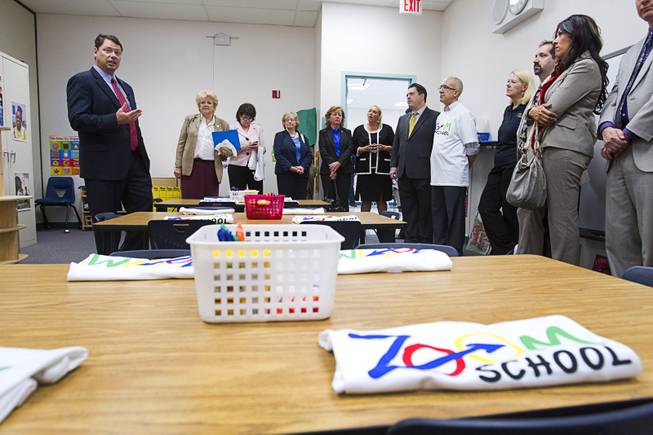
Clark County School District Superintendent Pat Skorkowsky shows off a pre-school classroom at Cambeiro Elementary School Monday, Aug. 26, 2013. The pre-school classes begin Sept. 3. The school is a “Zoom” school, one of 14 CCSD schools that will receive additional state money and resources to help students who don’t speak English.
Tuesday, Aug. 16, 2016 | 8:25 p.m.
Lawmakers put their finishing touches on an ambitious plan to reorganize the Clark County School District today, wrapping up nearly a year’s worth of planning that, if it passes legal muster, stands to permanently change the face of the country’s fifth-largest school district.
The nine-member reorganization committee, which has met on and off since last October, voted unanimously this evening to recommend a plan that would take power from the district’s central office of administrators and put it into the hands of school staff and parents.
Touted by its author, Canadian education reformer Michael Strembitsky, as a way to “right size” a school district that regularly ranks near the bottom in the nation, the plan would shift the focus of CCSD administrators from making top-down decisions to providing services to schools.
“It is time for change,” Las Vegas Mayor Carolyn Goodman told lawmakers gathered before a standing-room crowd downtown. “You can’t get much lower than 50.”
It’s the climax of a process that began during last year’s legislative session with the passage of AB394, a Republican-led bill that aimed to address the school district’s history of underperformance by limiting the power of the CCSD central office, which some see as stifling.
Many Democratic state legislators who originally opposed the bill slowly warmed up to the idea after the committee spent hours over the course of eight meetings taking community input and testimony from experts.
“I’ve been on record from the get-go saying I didn’t like the bill,” said Democratic state Sen. Aaron Ford, who sits on the committee. “But I’ve liked the process we’ve been engaged in the past few months.”
The resulting plan is an adaptation of what’s known as the “empowerment” model, an approach to schooling CCSD flirted with in 2008 but later dropped due to a lack of state support. Under the model, which is currently in use in other large districts such as New York City, school employees have the final say in things like staffing and budgeting, and principals have more freedom to run their schools as they wish.
Strembitsky, who pioneered the model and who was intimately involved in bringing it to CCSD 10 years ago, was paid six figures by the reorganization committee this year to come up with a way to expand the model to each of the district’s more than 350 schools.
There have been concerns about whether the model can be rolled out districtwide. Some warn that it will fail without parent involvement, a common problem in a transient city like Las Vegas, while others claim that not every principal will thrive with the autonomy.
“If the principal is not effective, the whole school is not going to reap the benefits of being autonomous,” said committee member and Democratic Assemblywoman Olivia Diaz.
However, it is that autonomy which legislators, union leaders and education advocates are banking on.
“If we take the shackles off [school staff] and give them an opportunity to work in a system that does not constrain them daily,” said Brent Husson, chief of education think-tank Nevada Succeeds, “we will see unbelievable results.”
Among the skeptics of the plan include the Clark County School Board, which has in turn faced criticism by some legislators, particularly committee chairman and Republican state Sen. Michael Roberson, for not being involved enough in the process.
While the board will remain in charge of picking the superintendent and overseeing the central office, trustees' ability to dictate districtwide policy will take a back seat to the staff at each school.
The board unanimously agreed on Aug. 3 that the plan posed “significant” problems for equity, and trustee Carolyn Edwards reaffirmed the board’s tepid response in public comment prior to today’s meeting.
“While some progress is being made, there continue to be legal issues that remain,” she said.
An immediate hurdle is the legality of the plan. Tod Story, head of the American Civil Liberties Union of Nevada, told the committee that parts of the plan contradicted administrative law, which could open it up to a lawsuit. Story and the ACLU are currently awaiting a ruling by the Nevada Supreme Court on a lawsuit they filed against the state’s new education savings account program.
A weeks-long schedule of public hearings designed to get feedback on the reorganization plan ended last Wednesday and sussed out other concerns, including worries among district support staff that the plan could allow principals to outsource jobs like custodial services.
The committee’s vote today revised the plan to keep support services handled at the central office level, though a number of support staff showed up at the meeting to voice their uneasiness.
The area where everyone seems to agree is that the success or failure of the reorganization will hinge on its implementation, which must be completed by the start of the 2017-2018 school year.
From today’s vote, the plan will go to the Nevada Department of Education, who will draw up the official regulations for the reorganization before it faces a final vote of approval from the Legislative Commission later this year.

Join the Discussion:
Check this out for a full explanation of our conversion to the LiveFyre commenting system and instructions on how to sign up for an account.
Full comments policy